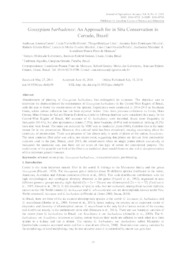Gossypium barbadense: an Approach for in Situ Conservation in Cerrado, Brazil.
Gossypium barbadense: an Approach for in Situ Conservation in Cerrado, Brazil.
Author(s): CASTRO, A. A.; HOFFMANN, L. V.; LIMA, T. H.; OLIVEIRA, A. I. D.; BRITO, R. R.; MENDES, L. de M. O.; PEREIRA, C. C. O.; MALAFAIA, G.; MENEZES, I. P. P. de
Summary: Abandonment of planting of Gossypium barbadense has endangered its existence. The objective was to determine the characteristicof the maintenance of Gossypium barbadense in the Central-West Region of Brazil, with the aim to foster the conservation of the species. Expeditions were conducted in 2014-2015 in Southeast Goiás, where cotton collection has not been reported before. Data from previous collections in Goiás, Mato Grosso, Mato Grosso do Sul and Distrito Federal available in Albrana database were considered this study. In the Central-West Region of Brazil, 466 accesses of G. barbadense were recorded, found most frequently in backyards (91.4%), but also spontaneous plants (7.5%), farm boundary (0.8%) and commercial farming (0.2%) have also been found. The main use indicated by VDU was as medicinal plant (0.66), therefore this is the main reason for in situ preservation. However, this cultural habit has been abandoned, causing uncertainty about the continuity of preservation. There was presence of lint almost only in seeds of plants of the variety brasiliense. The most common fiber color was white, not cream color, suggesting that plants are derived from commercial cultivars used in the past. Hence, until 2015, the conservation relies on single plants almost exclusively in backyards for medicinal use, and there are no crops of this type of cotton for commercial purpose. The exploitation of the possible use both of the fiber as a medicinal plant would foster ex situ and in situ preservation of this important genetic resource.
Publication year: 2016
Types of publication: Journal article
Unit: Embrapa Cotton
Keywords: Algodão, Cerrado, Cotton, Gossypium barbadense, Gossypium hirsutum
Observation
Some of Embrapa's publications are published as ePub files. To read them, use or download one of the following free software options to your computer or mobile device. Android: Google Play Books; IOS: iBooks; Windows and Linux: Calibre.
Access other publications
Access the Agricultural Research Database (BDPA) to consult Embrapa's full library collection and records.
Visit Embrapa Bookstore to purchase books and other publications sold by Embrapa.

